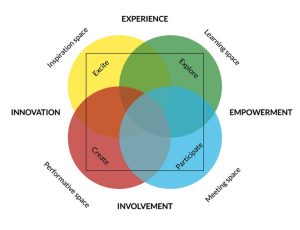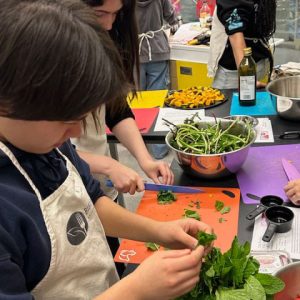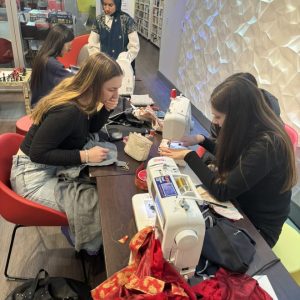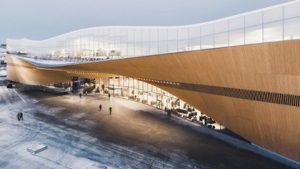Assignment X: Libraries of the 21st Century: Participatory Service and the Danish Four-Space Model
The library of the 21st century is more than books and an old woman with a bun and a “shush!” 21st century libraries are cultural centers, community hubs, and technological centers. This concept is born out of Denmark, the origin of the Four-Space Model of libraries. The Four-Space Model “illustrates a vision for the library. . . showing how the library can be developed from a passive collection of books and other media into an active meeting place to create connections between people, experiences, learning and inspiration” (Skot-Hansen, 2017). The four spaces, the inspiration space, learning space, meeting space, and the performative space, are centered around the idea of participatory service. Community members should have a sense of ownership of their library and in the Four-Space Model, are the center of planning and development.

Danish Four-Space Model
Participatory Service in Action
At the San Francisco Public Library (SFPL), “The Mix” is “a nearly 5000-foot section of the main library designed by its target audience: youth” (O’Brien, 2019). “The Mix” is a casual teen library space where teens can come and go as they please, making use of materials and programming, including a music studio, maker space, and book club, that they helped design.


The Mix at the San Francisco Public Library
The Helsinki Central Library Oodi in Finland has an entry full of chess tables and even a full kitchen where patrons can cook with friends, in addition to the usual books, games, maker spaces, and other participatory services (TheRuudy, 2022). “More than a new library, Oodi is a landmark in the heart of Helsinki for learning, cultural event space, and attracting tourists. In addition to providing traditional library services, the building’s modern and vibrant spaces serve as a cultural living room and multimedia centre for locals and visitors alike” (Ramboll, n.d.).

The Helsinki Central Library Oodi
The Toronto Public Library in Ontario, Canada publishes the Young Voices Magazine, “full of writing and art created and selected by Toronto teens” (Toronto Public Library, n.d.-c). A browse of teen programming reveals 263 results, including crochet club, karaoke night, Dungeons & Dragons, and dozens of various crafting nights (Toronto Public Library, n.d.-a). For adults and families, programs include neighborhood nature walks, book clubs, and even a workshop on gaining Canadian citizenship (Toronto Public Library, n.d.-b).
Young Voices Magazine, Toronto Public Library, Ontario, CA
Impact of Participatory Library Service
Libraries around the world are faced with the reality of technological advancement, AI, and changes in how we access information in the 21st Century. While books are vitally important, libraries can no longer survive by simply maintaining materials collections. In 2025, the library must adapt and progress with society, embracing new technologies while combatting the inevitable personal disconnection technology can induce. This is where participatory library service comes in. Creating spaces where community members can find connection and meaning is vital to the continuing legacy of the library.
Resources
O’Brien, C. (2019, June 24). How San Francisco’s public libraries are embracing their changing role. Shareable. https://www.shareable.net/how-san-francisco-public-libraries-are-embracing-their-changing-role/
Ramboll. (n.d.). Central Library Oodi, Helsinki. Ramboll. https://www.ramboll.com/projects/real-estate/central-library-oodi-helsinki
Skot-Hansen, D. (2017). Library development: From collection to connection. University of Copenhagen. chrome-extension://efaidnbmnnnibpcajpcglclefindmkaj/https://287.hyperlib.sjsu.edu/wp-content/uploads/2025/02/4-Spaces-Model-from-Univ-Copoenhagen.pdf
TheRuudy. (2022, December 13). Is this the world’s best library? [Video]. YouTube. https://youtu.be/wvyXjAI5_VI?feature=shared
Toronto Public Library. (n.d.-a). Programs & Classes. Toronto Public Library. https://www.torontopubliclibrary.ca/search.jsp?Nso=0&Ns=p_pub_date_sort&N=37867
Toronto Public Library. (n.d.-b). Programs for Teens. Toronto Public Library. https://www.torontopubliclibrary.ca/search.jsp?Erp=20&N=37867+4288063621&Ns=p_pub_date_sort&Nso=0&view=grid
Toronto Public Library. (n.d.-c). Young Voices Magazine. Toronto Public Library. https://www.torontopubliclibrary.ca/teens/young-voices/
3 Comments
Katelyn A.
Hi @aimes2025! I love that you wrote about the Danish Four-Space Model. I feel like most public libraries I enter are very good at creating the learning space (explore) and meeting space (participate) bubbles, but having active performative (create) and inspiration (excite) spaces are less common and often restricted to active events. Like Summer Reading Program activities or other things that might exist as a temporary event. The SFPL’s The Mix and the Helsinki Central Library Oodi sound like they’ve masterfully broken that barrier to activity by providing those concepts as live, drop-in/drop-out spaces.
missjennthelibrarian
Hello!
I like how you contrast the libraries of today with the libraries of the past, where you would find a staff member saying, “Shhhh!”. Libraries have evolved tremendously since then. You do a great job of referencing of these new models including “The Mix” in San Francisco and the Helsinki Central Library Oodi in Finland. My library system has been slow to evolve, but we are making some exciting changes.
Sue Donnim
@aimes2025 Great post with some great examples of how the modern library can be a destination for the community and visitors to that community. As an older (I hate to admit it) lady working in a library, I am very conscious of coming off as the shushing stereotype, especially when I wear my hair up 😁. But, I think as long as I embrace participatory culture, with the idea of the library existing as a space with resources to engage with the community, I’ll be able to overcome the stereotype. But something I’ve also been thinking about is how do libraries pull off this feat if they are located in conservative communities, with tiny budgets, and limited staff? It must be possible. It suppose it takes coming at the principles from a different angle and of course leaning into participatory service. @suedonnim